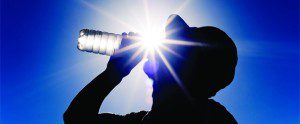

But summer isn’t all sunshine and rainbows – that very same sun that seems to stay out longer and longer with each summer can cause potential problems as well.
Beating the Florida heat and humidity can be challenging during the summer months. With these tips from Southwest Florida Urgent Care Centers, you can be better prepared for the summer heat.
When it comes to summer heat battle – precaution, awareness and, of course, a little sunscreen are your best friends!
Dehydration
Dehydration occurs when you lose more fluid than you take in and your body doesn’t have enough water and other fluids to carry out its normal functions. If lost fluid remains unreplenished, you may suffer serious consequences.
Common causes of dehydration include intense bouts of diarrhea, vomiting, fever or excessive sweating. Inadequate intake of water during hot weather or exercise also may deplete your body’s water stores. Anyone may become dehydrated, but young children, older adults and people with chronic illnesses are most at risk.
Mild dehydration can cause symptoms such as:
• Dry, sticky mouth
• Sleepiness or tiredness
• Thirst
• Decreased urine output
• Few or no tears when crying
• Muscle weakness
• Headache
• Dizziness or lightheadedness
Dehydration can be treated by replenishing the lost fluids your body has lost. Drink at least 32 ounces of water or sports drinks slowly and steadily. Rest, if you don’t feel better, drink more slowly and steadily.
Heat Cramps
Heat cramps are brief, severe cramps or spasms in the muscles of the legs, arms, or abdomen that may occur during or after vigorous exercise or working in extreme heat. The sweating that occurs causes the body to lose salts and fluids. This low level of salts causes the muscles to cramp. Although painful, heat cramps aren’t serious.
Even though you may be drinking water or other fluids, you can still have heat cramps as it is not dehydration, it is the loss of salts and other electrolytes such as calcium from your body.
If you suffer from heat cramps you should:
• Rest briefly and cool down
• Drink clear juice or an electrolyte-containing sports drink such as Gatorade.
• Do range-of-motion stretching and gentle massaging of the affected muscle group.
Heat cramps can be very painful, but they can be treated easily with the replacement of the electrolytes and generally are not serious.
Heat Exhaustion
Heat exhaustion is a condition whose symptoms may include heavy sweating and a rapid pulse, a result of your body overheating. It’s one of three heat-related syndromes, with heat cramps being the mildest and heatstroke being the most severe.
Warning signs of heat exhaustion include:
• Headaches, dizziness, lightheadedness or fainting.
• Weakness and moist skin.
• Mood changes such as irritability or confusion
• Upset stomach or vomiting.
• Heavy sweating
• Your skin may feel hot and moist and appear flushed
Causes of heat exhaustion include exposure to high temperatures, particularly when combined with high humidity, and strenuous physical activity. Without prompt treatment, heat exhaustion can progress to heatstroke, a life-threatening condition. Fortunately, heat exhaustion is preventable.
In most cases, you can treat heat exhaustion yourself by doing the following:
• Rest in a cool place. Getting into an air-conditioned building is best, but at the least, find a shady spot. Rest on your back with your legs elevated higher than your heart level.
• Drink cool fluids. Stick to water or sports drinks. Don’t drink any beverages that have alcohol or caffeine, either of which can contribute to fluid loss.
• Apply cool water to your skin. Take a cool shower or drench yourself with a water hose if possible.
• Loosen clothing. Remove any unnecessary clothing.
Heat Stroke
Heatstroke is a life-threatening condition that occurs when your internal body temperature reaches 104 F (40 C) or higher. Heatstroke is the escalation of two other heat-related health problems: heat cramps and heat exhaustion. You can prevent heatstroke if you receive medical attention or take self-care steps as soon as you notice problems.
Signs of Heat Stroke are:
• High body temperature. A body temperature of 104 F (40 C) or higher is the main sign of heatstroke.
• Cessation of sweating. This is often one of the first signs that your body temperature is too high. In heatstroke brought on by hot weather, your skin is hot and dry to the touch. Your body stops sweating.
• Hyperventilation. Your breathing may become rapid and shallow.
• Rapid heart rate and pulse.
• Seizures or Convulsions.
• Neurological symptoms. You may have seizures, lose consciousness, slip into a coma, hallucinate, or have difficulty speaking or understanding what others are saying.
Heat stroke always requires medical attention. If you see any of the above exposure signs, get the person out of the heat immediately and take them to the nearest hospital or call 911. Whatever the cause, you’ll need immediate medical attention to prevent brain damage, organ failure or death.
If you are out alone, or with loved ones, and notice any of the symptoms mentioned above, get out of the heat immediately. Drink cool fluids and wipe down the person with cool cloths. Seek medical help immediately if you suspect heat stroke.
Estero Medical Center
10201 Arcos Ave., Suite 105
Estero, FL 33928
239-333-2273
Cay West Pavilion
1708 Cape Coral Pwky. W., Suite 2
Cape Coral, FL 33914
239-333-3333
 Southwest Florida's Health and Wellness Magazine Health and Wellness Articles
Southwest Florida's Health and Wellness Magazine Health and Wellness Articles

